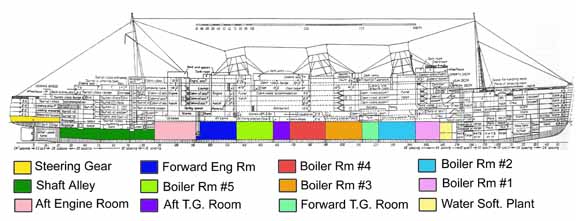
The arrangement of power train rooms seen from the side of the ship.
Click on all these pictures to expand them.
For sheer size and horsepower, the power train of the Queen Mary was probably the
largest ever built aboard a ship in human history. Absorbing the majority of the space on
the five lower decks of the 1,000 ft. long liner, it permitted the Queen Mary to wrest the
Blue Ribband from her great rival, the Normandie, and hold it unchallenged for well over a
decade.
The power train of the Queen Mary consisted of four primary boiler rooms each containing
six massive Yarrow boilers (for propulsion), an auxiliary boiler room with three Scotch
boilers (to generate electrical power for the ship's services), two turbo generator rooms,
two engine rooms and a feed water softening plant that was capable of producing 300 tons
of softened water every day to provide feed water that worked efficiently in the water
tube boilers.

The arrangement of power train rooms seen from the side of the ship.
Click on all these pictures to expand them.

A view of the power train from above on H deck, (modern G deck).
The Water
Softening |
The equipment in this room turned salt water into purified water for use in the boilers. |
|
Boiler Room #1 |
These boilers supplied steam for the ship's electrical generators for passenger and hotel services. It housed three "scotch" boilers. |
|
Boiler Room #2 |
Provided steam power for the ship's propulsion. |
|
The Forward Turbo
Generator Room. |
This room provided electrical power for the "hotel" part of the ship above. |
|
Boiler Room #3 |
Supplying steam for the ship's propulsion. |
|
Boiler Room #4 |
Supplying steam
for the ship's propulsion. |
|
The After Turbo Generator Room |
Supplied power for the ship's non-passenger electrical systems (pumps etc). |
|
Boiler Room #5 |
Supplied steam for the ship's propulsion. |
|
Forward Engine Room |
This room housed the propulsion machinery for the two outer propellers. |
|
After Engine Room |
This room houses the propulsion machinery for the two inner propellers. |
|
The Portside Shaft
Alley today |
This area houses the shafts running from the turbines to the propellers. |
|
The Steering Gear Room today. |
This area houses the hydraulic pistons which turn the rudder and the emergency steering wheel. |
1936-1967
During the entire service life of the RMS Queen Mary the power train functioned as
designed and built. During World War II, while the ship was used as a troopship sometimes
carrying as many as 16,000 troops at once, the power train was off-limits to allied
troops.
1968 to Present
While the new owners recognized the "icon" value of the ship, apparently few seemed to think that the public would be
interested in seeing and/or using the Queen Mary as she was when she came to them. The power train was
considered unnecessary since the ship was to be permanently docked. One engine room (the aft engine room), shaft alley and a single propeller were
retained in place. All of the other elements of the power train were gutted at great expense to create space for a massive
"Museum of the Sea".
This museum was the justification for the use of state tidelands funds to purchase the ship.
Initially the auxiliary boiler room, (Boiler Room # 1), that provided electrical power for the ship's hotel services was to be retained. But the
martitime museum developers demanded more space -- so it too was gutted. A new power plant providing alternating current was built on land at the
adjacent Pier J.
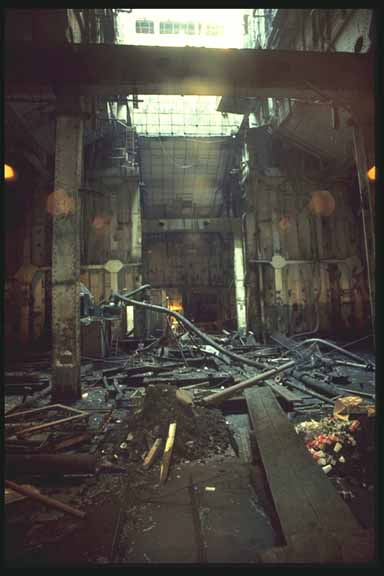

Looking forward from boiler room #4 , and (right) boiler room #2 (?) during the ripout
of the machinery in this area. The work is almost completed here. This area looks just
like this today, except that the mess on the floor has been cleared up and the funnel
hatches above sealed off.
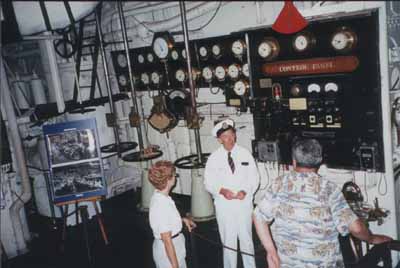 |
Today, only the aft engine room remains for visitors to
view.
Here, ex-crew member David Maine acts as docent, explaining the starting platform controls on August 5, 2000. |
The gutted lower decks of the Queen Mary are regarded by both the ship's owners (the City of Long Beach) and the ship's various operators (currently Save the Queen and their subcontractor Hostmark Hospitality Group) as an opportunity for commercial development. Over the years various suggestions have been considered including a factory outlet, a gambling casino, an IMAX theater, additional banqueting space, a brewery, and a "blitzkrieg" nightclub.
In the year 2000, the lessee RMS Foundation/QSDI, installed the Ghosts & Legends tour into boiler room 2, boiler room 1, and the water softening plant. An elevator was installed in the shaft of cargo hold 2 to take visitors to the upper decks, blocking the spectacular view of the hold. Read our article on the subject illustrating these areas today.
What does this mean for the historic ship? We believe it means that continued conversion of the Queen Mary, not restoration, is the goal of the operator.
Proponents of continued conversion believe that the current attraction, while not perfect, more than adequately responds to the needs and interests of the ocean liner buffs. To prosper, they believe that the Queen Mary needs to attract a broad audience who come to the ship for totally different reasons. Hence they are quite comfortable with removing original areas and auctioning original artifacts to build new features that were never part of the life of the Queen Mary as a great ocean liner.
This was the thinking in 1968-71 when the ship was converted and it is still the thinking today. The fact that the major new features imposed on the ship in the costly 1968-1971 conversion - e.g., the "Cousteau Living Sea Museum" and the two groups of tourist orientated shops on Sun deck - were both total failures - has not dissuaded them from this thinking. They believe that the wrong new features were picked in 1968-1971. They view their mission today as picking the "right" new features to add to the ship.
Today (left), Boiler Room #5 is a blue-carpeted exhibit hall. You can see the stumps of the outer propeller shafts in the distance in this picture.
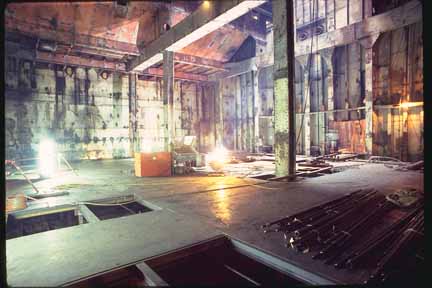
This area in mid-conversion. False flooring covers the boiler-beds.
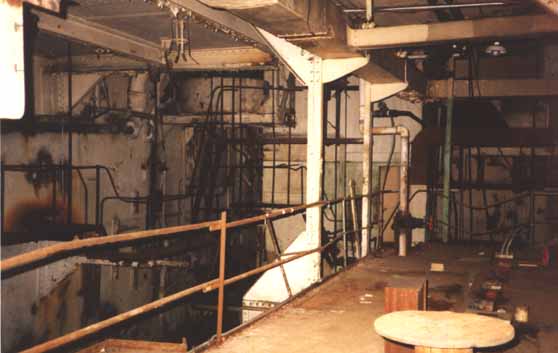
The Forward Turbo Generator room today - completely empty.
Let's look at the possibilities:
Option A
Mr. Robin Jacobs, a Queen Mary enthusiast, master model builder and craftsman, has developed a remarkable plan with accompanying model that demonstrates how a boiler room might be recreated as a full size simulation and used as a tour attraction in conjunction with what remains of the original power train known as “The Yarrow Project”. We support the Yarrow Project and believe that a more complete plan to recreate the major portions the Queen Mary’s power train will add a new dimension to the ship as an attraction that it has never had before. The single remaining engine room is one of the two most popular spots on the ship however it is all that remains of what was once a power train consisting of two engine rooms, two turbo generator rooms, four boiler rooms that provided steam to the engines, one boiler room that provided the ship’s hotel power, and a water softening plant.
As shown in the deck plan below, as an alternative to Mr. Jacobs plan, we propose to reconstruct the water softening plant, boiler room 1, boiler room 2, and the forward turbo generator room with full sized simulations of the machinery once found here. With this plan, one of each of the major components of the ship’s propulsion system would be available for viewing as a complete tour. The tour route would go as followed:
 Deckplan illustrating our preservation and adaptive reuse plan - Option A
Deckplan illustrating our preservation and adaptive reuse plan - Option A
·
Since Cargo Hold 2 is the main
cargo hold on the ship, the elevator equipment is relocated to Cargo Hold 1.
This elevator takes guests from R deck forward down to G Deck where they are led
aft into Cargo Hold Number 2. Perhaps the opening to this cargo hold might be
covered with a semi-clear weatherproof top that allows light to shine right down
to G Deck so that guests see this large and impressive hold at its best.
·
After this, guests are led aft to
the Water Softening Plant where they are given explanations of what the major
pieces of recreated machinery here once did.
·
Next, we move aft to Boiler Room
number 1 where guests see recreations of the large and impressive Scotch Boilers
that provided the ship’s hotel service power. Perhaps the present day heating
plant that the RMS Foundation placed on the wharf alongside the bow might be
relocated aboard the ship within these simulated Scotch Boilers.
·
Moving aft, guests are led into
Boiler Room 2 where they see the massive recreated Yarrow Water Tube Boilers
that won the Queen Mary the Blue Ribband from her rival, the SS Normandie.
(Perhaps the present air conditioning system for the entire ship might be housed
within these simulations.)
·
Finally, guests are taken aft to
the recreated Forward Turbo Generator Room and given an explanation about the
massive generators and switchboards that powered the ships systems.
·
After traversing the gutted
Boilers Rooms 3 and 4 which we assume will be re-developed for use in
conjunction with the current Exhibit Hall (it is comprised of the former aft
turbo generator room, Boiler Room 5 and the forward engine room) the tour
concludes by visiting the existing aft engine room, propeller alley, emergency
steering room and remaining propeller.
If the exhibit hall is retained as per our option A, it and the leftover space might be developed for use as a maritime museum honoring other famous ocean liners. These artifacts certainly couldn’t have a more perfect home than on the last great pre world war ocean liner left afloat! It would also serve as an interesting talking part between the two major portions of the power train tour. A well trained guide might even explain about the conversion while walking through this museum.
Option B
During the conversion, about half of C Deck was removed. This massive structural modification had major consequences for the Queen Mary in terms of her seaworthiness and structural soundness. If an enlightened operator wished to replace the missing half of this deck then the current exhibit hall would likely disappear. The current exhibit hall, as it is now, is a modern and stylistic intrusion in the fabric of the Queen Mary. It adjoins the only surviving engine room. Because of its totally unrelated "look" it makes developing a contiguous historic tour of the lower decks difficult, if not impossible. But what if the thirty year old power station that currently is housed on Pier J were replaced by a contemporary one using modern turbine technology that was placed aboard the ship itself in this exhibit hall? It might be new but it would fit in and in its own way reflect the evolution of the Queen Mary from ocean greyhound to shore-side attraction.
This new power station could be vented through the third funnel hatch and would permit the ship to be power self sufficient. In a real sense the Queen Mary would again become (and look like) a live ship. Because of the position of this area adjacent to the after engine room, it is even conceivable one day that the outbound propeller shafts might be reconnected to give the ship not just hotel power, but limited self-powered mobility!
![]() Deckplan illustrating our preservation and adaptive reuse plan - Option B
Deckplan illustrating our preservation and adaptive reuse plan - Option B
Forward Turbo Generator Room and Boiler
Rooms 3 and 4.
The illustration below shows how Robin Jacobs “Yarrow
Project” might be constructed in either boiler rooms 1 and 2, or as he planned,
in boiler rooms 3 and 4.
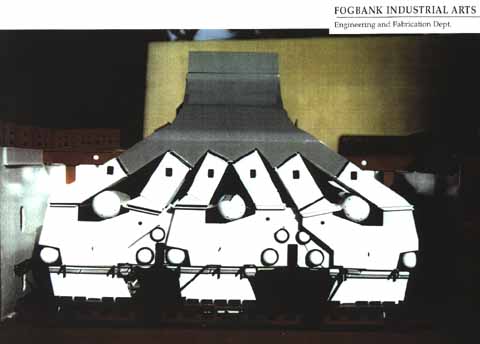
Robin Jacobs model of the proposed reconstruction of a boiler room. The above photo shows the boilers seen from the front of the ship, with the smoke uptakes going up to the funnel.
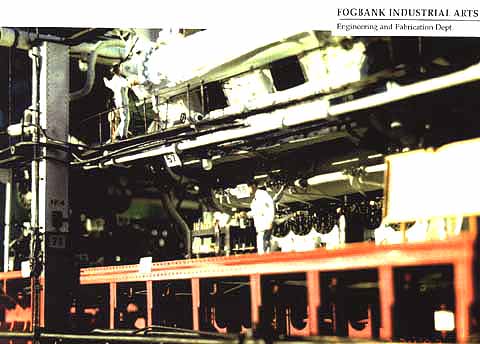
A
close-up of the boilers (boiler
room #4).
Pictures are copyright of
Fogbank Industrial Arts
The Queen Mary's power train was a critical element in making her the greatest ocean liner of the twentieth century. We recognize that recreating significant portions of this power train would be costly. It requires an enormous act of faith in the historic Queen Mary. But what could possibly be put down in these spaces that would be more intrinsically interesting than what was in them originally? And what would have longer term attraction value?
![]() Return to Index
by Deck
Return to Index
by Deck
![]() Return to
Index by Class of Accommodations
Return to
Index by Class of Accommodations